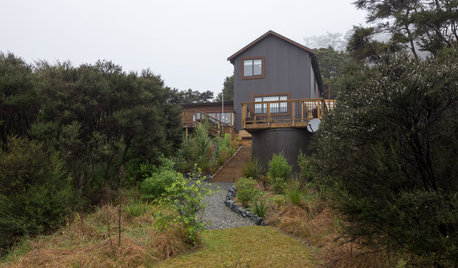Should I pass on Peace?
13 years ago
Featured Answer
Sort by:Oldest
Comments (41)
- 13 years agolast modified: 9 years ago
- 13 years agolast modified: 9 years ago
Related Discussions
Amish chairs, should we pass
Comments (6)I have to suggest to anyone shopping furniture not to get caught up in the quaint notion of something being "Built by the Amish" as a sign of either top-flight woodworking or exceptional value. I have never seen an Amish woodworking shop that I would consider "Master Cabinetmakers", most use fairly standard high-speed production techniques, and are not noticeably different from any other shop using modern equipment. Having said that, onto the question of screws in the joints. Sorry, I have to disagree with 'furnone'. Screws through the joints actually are a shortcut to proper time-tested methods, Its a short-term fix to what is essentially a bad joint design on the part of the maker, done in the interest of time and thereby a less expensive cost. If you want durability and longevity, then a Bore and Wedge joint is essential in an Windsor Style chair. You can see this easily in that the chair legs come through the seat and then then locked in with a driven wedge from the topside of the seat. If the chair is a Ladderback style, then the correct joinery is to use a long tenon going into a deep mortise, then glued and cross-pinned at 90 degrees with a small wood dowel. Of course, to get the highest level of construction, you will pay more than s 'screw and glue' method described in the Amish chairs. To do them right is labor intensive and that is reflected in the price of the goods. I would estimate most "screw and glue" chairs are good for 10 to 15 years before they begin break down (loosen), vs. properly constructed chairs that will last for several generations. -Duane Collie...See MoreShould I Open Up The Kitchen Pass Through or No? Advice Needed!!!
Comments (18)Whether to go down to counter height with the opening: Are you tidy? Do you leave things around the sink and will it bother you to see the backs of the things you leave around the sink from the other room? If you want to have a bit a screening around the sink I would leave it and you can create a countertop ledge/bar area at the higher level, the seating would have to be bar stools, not counter stools. If you don't want any screening of the sink from the other room, open it down to counter height....See MoreShould Estranged Son Be Notified When His Father Passes?
Comments (16)I'm so sorry, josephine. My friend/colleague's husband was on hospice. Trying to do the right thing, she told his horrible mother when he was within days of dying. His sister showed up & "read to him"...the only book she had in her car evidently- a Stephen King novel! Then his mother came by when he was sleeping, stayed about 2 minutes & left "instructions" with the nurses that they were to withhold his morphine so he'd be awake when she returned! After he died, the mother planned her own memorial service, separate from the one the widow had, & notified facebook that she was next-of-kin & his facebook account now belonged to her. & facebook turned it over to her. My friend hasn't had any luck getting facebook to respond to her, so she can't access his account, can't get those memories, etc. & his mother can, & does, use the account to dramatize her own "loss". so I'd say, don't let anybody know anything until you've taken care of everything & they can't make trouble. Cash the insurance policy, have the funeral, get the bank accounts & internet accounts locked up, probate the will. Whatever you do, don't take chances; protect your loved ones, & protect yourself. The loss of a gravy train is indeed traumatic, & vicious people have a field day whenever there's a crisis or loss. Financially & emotionally, they feed off things like this. Take care....See MoreNot cooking related but should be viewed and passed on
Comments (4)I've never sent a text, and I had my cell phone turned off a few months ago and do not miss it. I also drive very little, and on week-ends Kevin drives us to the stores. I wonder why no one seems to be getting tickets for driving while texting. My not-too-bright niece had a layover in L.A. a few years ago (back when I lived in Venice), and she was unable to call me using a pay phone at the airport because she kept dialing 1+area code, and I was in the same area code as the airport, and back then, you did not have to dial the area code, and so she had to borrow someone's cell phone to call me. We did buy a cell phone in Orvieto, Italy (on our way to Florence) so that I could call the hotel and confirm where to park and exactly how to get there, but I used the phone while Kevin was driving. I also had a cell phone in Costa Rica (to call hotels), but again I used the phone while Kevin was driving. I guess most of my cell phone conversations have been either in Italian or Spanish. We had GPS in the cars in both Italy and Costa Rica, but sometimes that was not enough, especially when roads were unexpectedly closed. Before we were so connected, we may have gotten lost a bit more often, like Kevin and I did on our first trip to Death Valley....See More- 13 years agolast modified: 9 years ago
- 13 years agolast modified: 9 years ago
- 13 years agolast modified: 9 years ago
- 13 years agolast modified: 9 years ago
- 13 years agolast modified: 9 years ago
- 13 years agolast modified: 9 years ago
- 13 years agolast modified: 9 years ago
- 13 years agolast modified: 9 years ago
- 13 years agolast modified: 9 years ago
- 13 years agolast modified: 9 years ago
- 13 years agolast modified: 9 years ago
- 13 years agolast modified: 9 years ago
- 13 years agolast modified: 9 years ago
- 13 years agolast modified: 9 years ago
- 13 years agolast modified: 9 years ago
- 13 years agolast modified: 9 years ago
- 13 years agolast modified: 9 years ago
- 13 years agolast modified: 9 years ago
- 13 years agolast modified: 9 years ago
- 13 years agolast modified: 9 years ago
- 13 years agolast modified: 9 years ago
- 13 years agolast modified: 9 years ago
- 13 years agolast modified: 9 years ago
- 13 years agolast modified: 9 years ago
- 13 years agolast modified: 9 years ago
- 13 years agolast modified: 9 years ago
- 13 years agolast modified: 9 years ago
- 13 years agolast modified: 9 years ago
- 13 years agolast modified: 9 years ago
- 13 years agolast modified: 9 years ago
- 13 years agolast modified: 9 years ago
- 13 years agolast modified: 9 years ago
- 13 years agolast modified: 9 years ago
- 13 years agolast modified: 9 years ago
- 13 years agolast modified: 9 years ago
- 13 years agolast modified: 9 years ago
- 13 years agolast modified: 9 years ago
- 13 years agolast modified: 9 years ago
Related Stories

LIFE13 Ways to Keep the Peace With Roommates
A few ground rules will help you sidestep conflicts over dirty dishes, laundry, decorating, groceries and more
Full Story
KITCHEN DESIGNKitchen of the Week: A Separate Peace for a Manhattan Studio
Savvy design tricks help a petite urban kitchen look not just separate, but visually distinct
Full Story
FEEL-GOOD HOME10 Tips for a More Peaceful Home
Turn your everyday living space into a serene retreat by clearing visual distractions, softening your lighting and more
Full Story
FEEL-GOOD HOMETap Into Your 5 Senses to Find More Peace at Home
Counteract screen overload and stress by rediscovering basic ways to enjoy life
Full Story
ROOM OF THE DAYRoom of the Day: A Peaceful Library Serves as a Couple’s Retreat
Heirlooms, books and other meaningful items all have a place in this cozy Dallas room
Full Story
CONTEMPORARY HOMESMy Houzz: Urban Space With a Peaceful, Easy Feeling
A Dublin fashion designer personalizes her home with vintage finds, comfortable furnishings and a calm palette
Full Story
HOMES AROUND THE WORLDMy Houzz: A Peaceful Retreat Perched in the Wilderness
A couple of chocolatiers find a secluded sanctuary in New Zealand to build the home of their dreams
Full Story
KITCHEN DESIGNDon't Pass Up the Kitchen Pass-Through
A carved-out opening in a kitchen wall can increase spaciousness, make an architectural statement and improve social time
Full Story
HOUZZ TOURSMy Houzz: Peacefulness and Pugs in Tampa
Soothing colors and cushy furniture make for a comfy-cozy apartment for a shop owner and her pets
Full Story
DECORATING GUIDESNeed Peace and Quiet? Muted Colors Tone Things Down
Subtle hues can be perfect for large rooms and to balance out bolder colors in a home
Full Story





harryshoe zone6 eastern Pennsylvania